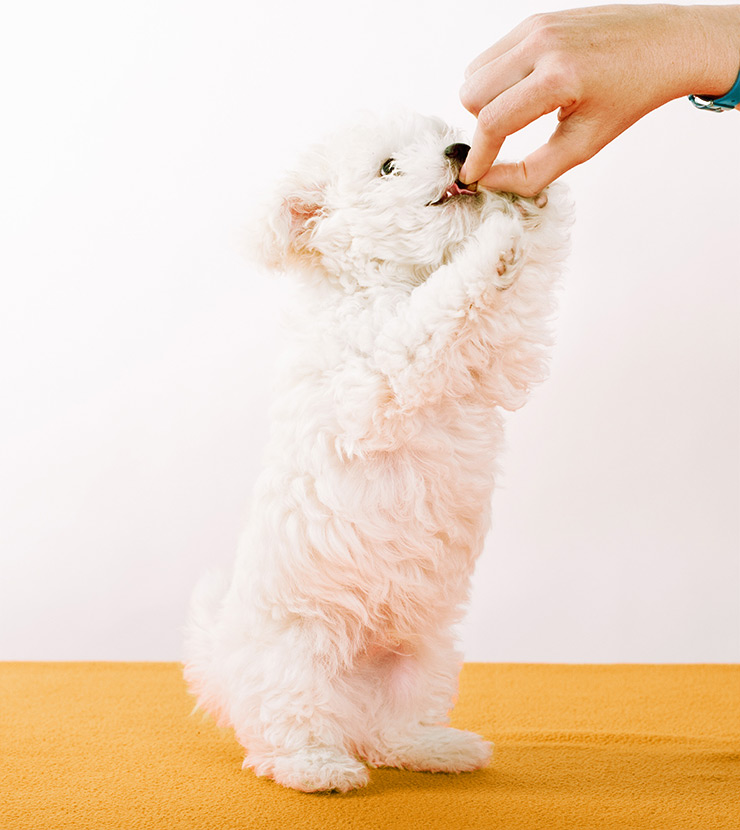3 Simple Steps to Train Your Dog to Stand on Two Legs

It is amazing how dogs can be trained to execute a variety of commands. They can learn to bark on command, kiss, sit, hug, fetch, spin, play dead, roll over, shake hands, and even stand on two legs. Moreover, you can even potty train your puppies.
Before you attempt to train your dog to stand on two legs, you need to realistically appreciate that the particular posture isn’t a dog’s natural behavior. For this reason, it will take time and effort for your pet to fully grasp this new behavior. The standard learning curve needs to be appreciated. This training is particularly uncomfortable for larger dogs compared to small ones. As a precaution, you need to evaluate the health status of your dog’s hind legs and hips. In the event there’s a history of injury to these parts, you need to abort the mission. Also, as a precaution, young puppies, or dogs that are arthritic, have hip dysplasia, have trouble moving due to injury, disease, or neurologic disorders, or show lameness in any capacity should not attempt this trick.
Follow the following steps to train your dog to stand on two legs:
Step 1: Create a reward system
The main aim of this step is to show the dog that there’s a reward for standing on two legs. This reward motivates the dog to learn to stand on two legs.
- You begin by making sure the dog assumes a sitting position before you dangle a treat above its head. Then, proceed to move the treat upwards and towards the dog’s back. The dog, seeing this, will attempt to get its front feet off the ground. Make sure you reward the dog when it this happens.
- Repeat this several times, seeing to it that you move the treat higher and higher with each subsequent attempt. The dog, associating the reward with its effort to lift its front limbs from the ground, will keep on trying to perfect the act.
- Towards the end of this step, the dog should demonstrate the ability to stand on its hind feet comfortably. To achieve the best result, you shouldn’t allow the dog to put its paws on you while attempting to stand. This way, the dog will learn to independently balance itself.
Step 2: Conditioning a hand signal
- After successfully showing the dog how to stand on its two feet with a treat, in this next step, the aim is to get the dog to do it even in the absence of a treat. The dog should be able to stand without you holding a lure above its head.
- Therefore, you make your hand signal look identical to your treat/lure. You make hand signals just as you did in the first step but this time, there’s no food inside your hand. With successive attempts, you can make minor changes to your hand signal by, for example, using your index finger to point up as the hand signal.
- When the dog makes successful standing attempts, you still reward it. You need to be sure that the dog is fully compliant with the hand signal before moving to next step.
Step 3: Conditioning a verbal signal
- After the dog can stand on two legs courtesy of a hand signal, you then introduce the concept of a verbal signal. The dog is supposed to follow this verbal command just as it did the hand signal.
To achieve this, you utter the command then follow it up with the usual hand signal. For proper learning, you are supposed to ensure there’s a small pause between the verbal command and the hand signal. For instance, you say “Stand,” followed by a pause before the hand signal. The dog will register that a verbal command is what triggers the hand signal. - If your dog isn’t responding well to verbal commands and hand signals, go back to the beginning or to the point where the confusion starts, and try again.
Excited as you are to teach your dog how to stand on its two legs, don’t expect it to learn overnight. Give it time to learn.
----------
 I’m Cindy Grant, founder of NolongerWild.com and also a crazy fan of dogs, cats and all kinds of in-house little cute pets. Feel free to read all amazing things about Pet’s Breed, Training, Behavior, Food and Health on my blog. With such big passions in pets, I strongly hope NolongerWild will be a friendly community where I can connect with those who share the same hobby.
I’m Cindy Grant, founder of NolongerWild.com and also a crazy fan of dogs, cats and all kinds of in-house little cute pets. Feel free to read all amazing things about Pet’s Breed, Training, Behavior, Food and Health on my blog. With such big passions in pets, I strongly hope NolongerWild will be a friendly community where I can connect with those who share the same hobby.










